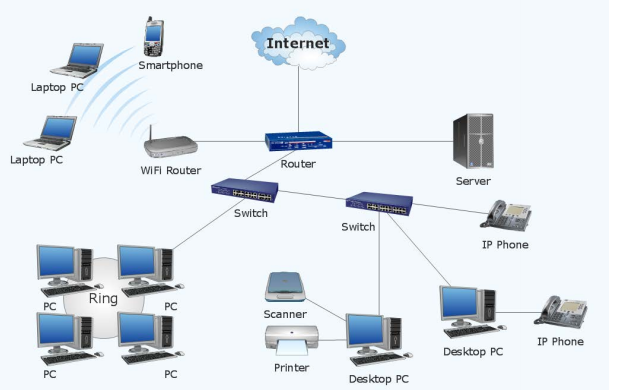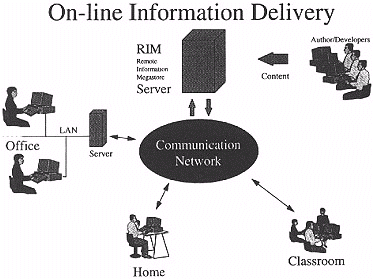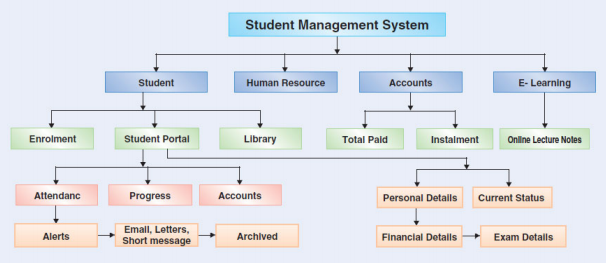Reviewing Online Education System
IT Infrastructure assessment
Background
The management of AusEd has decided to review the existing information technology infrastructure to cater for the increasing demand for better services for both staffs and students. Assume that you are the IT Infrastructure manager for AusEd. Further, you were assigned the responsibilities to review the exiting IT Infrastructure for the purpose creating a proposal for a new IT infrastructure.
Your Project
Please read the case study for AusEd posted in the LEO. The ISYS201 assessment 2 is about creating an overall IT Infrastructure proposal for AusEd. The proposal is an overview of the entire IT infrastructure to be presented to the AusEd management for future planning. The proposal will include IT Infrastructure diagram of the overall system. The diagram will include network infrastructure, all types of servers and clients as well as where they are located within the network. Indicate the presence of security features such as firewalls, VPNs. Finally briefly describe how the various sections of the plan serve the business needs of the internal and external users of the system.
Criteria of stage 1 report
- Project Preliminaries Description (5%)
- Purpose and scope of the problem space as well as business context (10%)
- Scope of the system descriptions and assumptions (10%)
- Appropriate System design by using suitable schematic diagrams (30%)
- A complete list of equipment, devices necessary for the design. (10%)
- A cost analysis of the proposed Infrastructure design. (20%)
- Consider and apply techniques for achieving sustainable global economy and environmental responsibilities, e.g. e-waste, green IT consideration. (10%)
- Appendix (bibliography, glossary of terms) (5%)
Formula to calculate mark = mark allocation for a criterion * achievement level
Appendix B
GRADING RUBRIC FOR PRACTICAL- INFORMATION TECHNOLOGY INFRASTRUCTURE DESIGN (TOTAL MARKS =30 MARKS)
Intended Learning Outcomes (ILOs)
- Plan an IT infrastructure solution for a small organisation, including a network based on standard technology components, servers, security devices, and several different types of computing clients. The IT infrastructure solution should aim at achieving sustainable global economy and environmental responsibilities
| ILO | Criteria | Standards | ||||
| Below Expectations | Meets Expectations | Exceeds Expectations | ||||
| Level 1 (e.g. F) | Level 2 (e.g. P) | Level 3 (e.g. C) | Level 4 (e.g. D) | Level 5 (e.g. HD) | ||
| 5 | A report which demonstrates thorough understanding of the context within which projects are implemented and a realistic approach to achieving project success. (15 Marks) | No submission or
submission containing little or no material relevant to a potential project sponsor. |
Many omissions and/or
inconsistencies such that a potential project sponsor would not consider offering the project to the student. |
Some omissions and/or
inconsistencies which might raise some concerns in a potential project sponsor as to the student’s capabilities and/or motivation. |
Sufficient detail such that a potential project sponsor could be satisfied the student is aware of and understands all obvious relevant issues. | All relevant information provided leaving little or no need for follow-up
questions from a potential project sponsor. |
| 5 | A well-structured and
understandable report appropriate for an audience of project sponsors. (15 Marks) |
No submission or material in the submission
incomprehensible. |
Submitted late
and/or much too long or too short and/or illogical structure or inconsistent style. |
Submitted on time and of adequate size but not
demonstrating a serious attempt to engage the audience and/or cater to the audience’s expectations and requirements. |
A serious attempt to cater to the expectations of a
potential project sponsor but nonetheless with opportunities to improve in structure, presentation etc. |
A clear, concise, well
structured and easily understood communication. |
Contents
System description and assumptions: 4
System design and schematic diagram: 5
List of equipment and devices for design: 6
Techniques for sustainable global economy: 10
Project description:
The project of AusEd is actually a new age innovative technology application that helps in supporting online teaching and learning. This way the company has created a project that is committed to offer teaching through use of internet facility by the students. The efforts are made to reach out to the potential students in the remote regions so that the objective of spreading education through online medium can be met. In addition the company provides online teaching facility to the faculties of the companies. This way these faculty members are allowed to teach students from the comfort of their home or office and without travelling to distant places as student home. Online education helps the teachers to teach number of students at one time. This process of teaching and learning is highly cost effective and has proved blessings for students who were looking for cost effective learning experience.
Purpose and scope:
The purpose of the business is to spread education to remote students through online medium. This way the main objective is to teach online and develop an innovative learning experience. In addition the purpose of the business is to offer online earning facility to the teachers who are willing to teach online.
The scope of the problem space therefore is to identify the various methods that could support the online learning experience. The problem is therefore to apply the most effective learning sessions so that the student could avail maximum benefits from it. In addition the problem is to identify the potential students and attract towards online learning experience so that the business could grow and prosper.
The business context is to develop area of operation from national to international levels. Therefore the company is making consistent efforts to develop business in the country as well as overseas so that long term sustenance and growth can be achieved.
System description and assumptions:
The scope of the system description will include teacher, students and supporting technology that will help offering quality educational service to the students.

The system description is depicted above. This clearly states that the company server will be connected to the router which will ring to various PCs of teachers who will be delivering online education. ON the other hand, router will offer connection with the students so that they can use their smartphones or laptop PC for the purpose of attaining online education. The switching between the teacher PC and student PC as per the requirements will be done by the administration who will keep a close track of development on regular basis.
The assumptions that are taken into consideration include the followings.
- The IT department of the company wants to speed up the process of giving services to the teachers and students through development of data centers.
- The company wants to deploy security assessment criteria’s so that IT operation of the business could be secured from any kind of security threat in the operational environment.
- The company intends to shift to open source technology by migration of the system from Windows to Linux operating system.
- The company wants to develop smart phone applications so that the students can be facilitated in the learning process.
- The company intends to shift to cloud based database management system so that the business process could be supported with latest inputs available from anywhere provided the authorization and internet connections are available.
System design and schematic diagram:
The appropriate system design by using suitable schematic diagram can be stated below.

It is clear from the above schematic diagram that the use of communication network will be use through server as main body where the transformation of information takes place. The server will assist in exchange of information data from teacher to students. The teacher could work from home and create an online class room experience in which the students attend the online sessions. The authors and developers send contents to the teacher through server so that a particular process of learning can be initiated. The office server keeps close track of the proceeds so that code of conduct is followed by the teachers and students as well.
List of equipment and devices for design:
The list of equipment and devices necessary for the design include the followings.
- Internet
- IP phone.
- Desktop PC.
- Laptop PC.
- Switch
- Scanner
- Printer
- Router
- Wi-Fi Router.
- Smart phone.
The internet connections could help in transfer of information through different routers deployed by teacher, students and administrator. The use of above list of equipment can therefore be used for connecting the receiver with the sender through different electronic devices that includes smartphones, laptops and desktops. The students could therefore use their electronic devices for getting information from the teacher which are closely monitored and controlled by the administrator. The company server will be connected to the router which will ring to various PCs of teachers who will be delivering online education. ON the other hand, router will offer connection with the students so that they can use their smartphones or laptop PC for the purpose of attaining online education. The switching between the teacher PC and student PC as per the requirements will be done by the administration who will keep a close track of development on regular basis.
The service design that will be followed in online tutoring can be stated as below.

Thus we see that the complete student management system is applied under which the student, human resource, accounts and eLearning are taken care of. The student portal takes care of enrolment, library, progress, attendance, alerts and accounts. On the other hand, accounts take care of total amount paid by the student, installment, personal details, current status, financial details and exam details. Finally eLearning takes care of online lecture notes.
Cost analysis:
The cost analysis of the proposed infrastructure design can be done as follows.
| Product | Cost in USD. | Expenditure to be borne by |
| v Internet. | 30 | Teacher, student, administrator |
| v IP phone. | 60 | Administrator |
| v Desktop PC. | 500 | Teacher, student, administrator |
| v Laptop PC. | 700 | Teacher, student, administrator |
| v Switch. | 100 | Administrator |
| v Scanner. | 75 | Administrator |
| v Printer. | 50 | Administrator, student |
| v Router. | 100 | Teacher, student, administrator |
| v Wi-Fi Router. | 120 | Teacher, student, administrator |
| v Smart phone. | 150 | Student |
The project of AusEd is actually a new age innovative technology application that helps in supporting online teaching and learning. This way the company has created a project that is committed to offer teaching through use of internet facility by the students. The efforts are made to reach out to the potential students in the remote regions so that the objective of spreading education through online medium can be met. In addition the company provides online teaching facility to the faculties of the companies. This way these faculty members are allowed to teach students from the comfort of their home or office and without travelling to distant places as student home. Online education helps the teachers to teach number of students at one time. This process of teaching and learning is highly cost effective and has proved blessings for students who were looking for cost effective learning experience.
Techniques for sustainable global economy:
The techniques that could be applied for achieving sustainable global economy and environmental responsibilities include the followings.
- The efforts should be made to avoid e-waste through recycling of the electronic products that does not perform well.
- The green IT consideration requires to be taken into consideration by making maximum use of computer files than paper documents so that the green initiative can be taken and paper usage could be curtailed.
- The use of computer graphics and later printing should done after careful selection and completion of the work so that more unnecessary print outs are not made.
Conclusion:
In conclusion AusEd requires to consistently upgrading its services so that the students could be offered maximum benefits possible. Attempts should be made towards improving the technological aspects of the business so that the interconnection made could offer value added services to the customers. In addition the teachers are required to be given online training at regular intervals so that their skills can be improved towards delivering quality online education to the students. The green technology initiative should also be applied so that the business could maintain its steady growth and development.
Bibliography
Azim, R. & Hassan, A., 2013. Impact analysis of wireless and mobile technology on business management strategies. Information and Knowledge Management, 3(2), pp.141-50.
Beecham, S. et al., 2008. Motivation in Software Engineering: A systematic literature review. Information and Software Technology, 50, pp.860-78.
Brynjolfsson, E. & Hitt, L.M., 2000. Beyond Computation: Information technology, organizational transformation and business performance. Journal of Economic Perspectives, pp.23-48.
GriffithUniversity, 2014. Programme Information and Research Project Areas. School of Medical Science Projects, 1, pp.1-85.
Karim, Z., 2009. Towards secure information systems in online banking. In International Conference for Internet Technology and Secured Transactions. London, 2009.
Karim, A.J. & Hamdan, A.M., 2010. The impact of information technology on improving performance matrix: Jordanian banks as case study. In European, Mediterranean and Middle Eastern Conference on Information Systems. Abu Dhabi, 2010. EMCIS2010.
Khan, A.A., Zaman, N. & Dawood, M.U.Z., 2008. Online Banking Transaction System. Journal of Information and Communication Technology, 2(2), pp.90-100.

Leave an answer